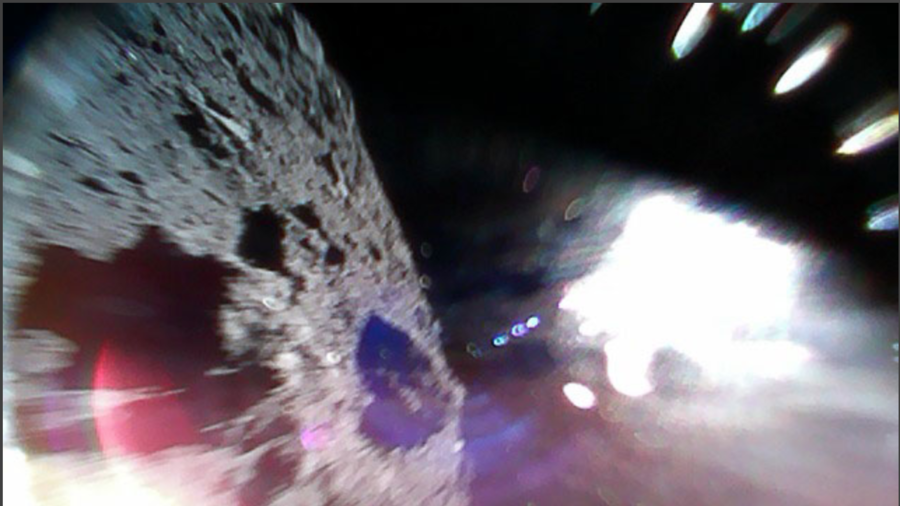Japan’s ‘hopping rovers’ successfully land & send first images from Ryugu asteroid (PHOTOS)

A pair of tiny JAXA robots, released by the Hayabusa2 probe, have successfully landed on the Ryugu asteroid and began transmitting images from the surface of the “potentially hazardous” object four years after the mission launch.
The first images from the astronomical object flying at some 300 million kilometers from the Earth were received by Japan’s Aerospace Exploration Agency (JAXA) immediately after the MINERVA-II1 rovers touched down on the asteroid on Friday.
The first image was taken after the separation of the two cylinder-shaped explorers from the Hayabusa2 space probe. Snapped while the rover was rotating, the blurred image shows Hayabusa2 at the top of the screen with the surface of Ryugu depicted at the bottom.
This is a picture from MINERVA-II1. The color photo was captured by Rover-1A on September 21 around 13:08 JST, immediately after separation from the spacecraft. Hayabusa2 is top and Ryugu's surface is below. The image is blurred because the rover is spinning. #asteroidlandingpic.twitter.com/CeeI5ZjgmM
— HAYABUSA2@JAXA (@haya2e_jaxa) September 22, 2018
The second image received on Earth was captured by Rover-1B and shows a much clearer definition of the surface of Ryugu in the lower right corner, with sunlight reflection visible on the top left. The third image released by JAXA was snapped by Rover-1A as it hopped on the surface of its target, offering yet another glimpse of the mysterious object.
Photo taken by Rover-1B on Sept 21 at ~13:07 JST. It was captured just after separation from the spacecraft. Ryugu's surface is in the lower right. The misty top left region is due to the reflection of sunlight. 1B seems to rotate slowly after separation, minimising image blur. pic.twitter.com/P71gsC9VNI
— HAYABUSA2@JAXA (@haya2e_jaxa) September 22, 2018
“MINERVA-II1 is the world’s first rover (mobile exploration robot) to land on the surface of an asteroid,” JAXA said. “This is also the first time for autonomous movement and picture capture on an asteroid surface.”
"I cannot find words to express how happy I am..." Y.T.The MINERVA-II1 rovers have successfully landed on asteroid Ryugu, snapped photos & taken the first successful hop! Have a read about this world first and hear the comments from our Project Members.https://t.co/xtoIcWIT5Xpic.twitter.com/AOYDhhBDe2
— HAYABUSA2@JAXA (@haya2e_jaxa) September 22, 2018
Measuring just 18-by-7cms and weighing about one kilo, MINERVA-II1 rovers will take advantage of Ryugu’s low gravity to hop about the surface of the asteroid, which is approximately one kilometer in diameter. The robots will take photos and temperature readings of Ryugu before Hayabusa2 space probe lands on the asteroid’s surface in 2019.
Microscopic ‘grain’ of asteroid Itokawa revealed in mindblowing close-up (PHOTO)
Hayabusa2 was launched in December 2014 and made its rendezvous with Ryugu in June this year. Once the probe completes taking samples from the asteroid, it will head back to Earth in late 2020.
Like this story? Share it with a friend!














